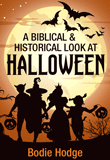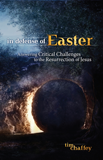
Happy Holidays
How Did We Get to This?
As Christians, we don’t know whether to be sad, angry, or indifferent.
During the coming holidays, will your focus be on barcodes or Bethlehem? On the risen Savior or a chocolate bunny?
The frustrating reality is that, for most in our culture today, secularism has almost fully obscured the roots of many holidays. In many cases religious tradition has overgrown its original intent—so much so that we must ask ourselves a few very important questions: What are the foundational origins of the holidays? How are Christians to correctly lead their families as they seek to worship the Lord during these special seasons of the year?
Answering these questions is not as simple as it might seem. Every Christian holiday has become a mixture of the secular and the sacred—a smearing of the historical and the fable, and often it’s hard to tell which is which.
Holiday Quiz—How well do you know the history behind some of the holidays?
- What meats made up the Thanksgiving meal of the Pilgrims?
- Why do we give candy to trick-or-treaters on Halloween?
- Why is the day after Thanksgiving called Black Friday?
- Why is the shamrock associated with St. Patrick’s Day?
- What prominent Christian event occurred October 31, 1517?
- Why is the poinsettia associated with Christmas?
- Why do we celebrate Easter with eggs and a bunny?
- Why does Santa Claus wear red?
- Who really was St. Nicholas?
- True or False: A star led three wise men to the stable to see Jesus.
See answers below.
Christmas
96% of all U.S. adults celebrate Christmas. Amazingly, even 84% of those who claim to be non-Christians celebrate this religious holiday.1
During the Christmas season, believers in Christ commemorate the coming of Immanuel, which means “God with us” (Matthew 1:23). This miraculous and holy event is illuminated in the beautiful words of Scripture that detail the events surrounding Christ’s amazing birth.
The Christmas season has long been a mixture of both the secular and sacred. During the church’s first three centuries, Christmas wasn’t even on the calendar yet. Initially, the celebration of Christ’s birth was lumped in with Epiphany on January 6, one of the church’s earliest feasts. Some thought that it would be wrong to honor Christ’s birthday since birthday celebrations were for pagan gods. The date December 25 places Christmas in the middle of a significant pagan winter festival that celebrates the rebirth of the sun using bonfires and evergreen trees. The mixture of traditions between the pagan holiday and the Christian holiday is seen today in everything from snowy nativity scenes to stars on decorated pine trees.2
For hundreds of years, Christmas has also been the flashpoint of bitter legal and social battles. During the 1500s and 1600s, the celebration of Christmas was banned for a time in Scotland, England, and Massachusetts, but not for reasons you might expect. Many Puritans and Protestants believed that the holiday was so secularized that it had become a blasphemy against God. The opposite is the case today as Christian aspects of the holiday are brought under attack by liberal government and special interest groups.
Today, green liquor and leprechaun hats are the dominant features of St. Patrick’s Day.
St. Patrick’s Day
St. Patrick (his birth name is believed to have been Maewyn Succat) was born in Britain to wealthy parents near the end of the fourth century. When he was sixteen, his family’s estate was attacked by Irish raiders, who took him captive for six years and forced him to work as a shepherd. Alone in the hills, he remembered the Scriptures, which he had been taught, and turned to God for comfort. In the solitude he developed a rich, personal relationship with Christ.
St. Patrick eventually escaped back to Britain, yet God called him to return to Ireland as a missionary. St. Patrick traveled the roads and forded the rivers of Ireland for 30 years, tirelessly sharing the gospel.
By the time of his death, Patrick had baptized tens of thousands and established hundreds of churches. In fewer than 100 years, the pagan country of Ireland became predominately Christian, eventually sending missionaries of their own to Scotland, England, Germany, and Belgium.
March 17, the date of his death, is an Irish national religious holiday. Until the 1970s, Irish laws even mandated that pubs be closed on this date. Tragically, this holiday is now associated with shamrocks, beer, and a pinch if you forget to wear green.
A porch light, some candy, and gospel tracts can help turn this secular holiday into a soul-winning experience.
Halloween/All Saint’s Day
Halloween, as we know it today, has its origins in the pre-Christian Celtic “Festival for the Dead.” In an attempt to Christianize this pagan event, Pope Gregory III moved “All Saints’ Day” from May to November 1 in A.D. 800 with the intent of honoring the lives of the saints. In addition to this original intent, churches began staging pageants in which people dressed up as saints or demons to scare away the real demons associated with the festival.
Rather than helping Christianize the Celts, Christians were drawn into compromise. Later, October 31 was set aside as a “Holy Evening,” also known as All Hallows Eve, which then became Hallowe’en, in an attempt to give Christians a spiritually edifying alternative that would allow them to proclaim the supremacy of the gospel over pagan superstition.
Unfortunately, these efforts appear to have had little positive effect over the centuries. In the western world, few people are aware of the Holy Evening or recognize All Saints Day, but for retailers the Festival of the Dead is big business. According to a recent USA Today article, Halloween spending in the United States surpasses $3 billion annually.3
Easter
He is risen!” Around the globe these joyous words permeate the stillness of Easter morning as followers of Christ commemorate the events of Holy Week. During this holiday we remember Jesus Christ and how He, the last Adam, shed His blood as the perfect, final sacrifice, then proved His power over death as the risen Savior. Christian celebrations often include communion and special emphasis on Christ’s crucifixion and resurrection.
The Easter season has many nonbiblical elements as well. The date for Easter coincided with the pagan celebrations of spring, from which the Easter bunny and Easter eggs emerged.
Even the origin of the holiday’s name, Easter, is uncertain. Some believe it is derived from the word “Pesach” (the Hebrew word for “Passover”), but other historians believe it may have been adopted from the name of an Anglo-Saxon goddess of fertility named “Eostre.”
Prayer and thanksgiving to our Creator and Provider should be the dominant focus on this festive holiday.
Thanksgiving
The American Thanksgiving celebration is a beautiful example of a Christian holiday that has largely retained its original purpose. After leaving England in search of religious freedom and a new start in life, the Pilgrims settled in Holland. However, they soon sailed from Holland to the New World. They braved the storm-tossed Atlantic Ocean, only to see half of their friends and family members ravaged by sickness and death during the harsh New England winter. Diligent in faith and work, and assisted by Indians, they reaped a bountiful harvest the following summer. The grateful Pilgrims then declared a three-day feast in December 1621 to thank God and to celebrate with their Indian friends. It was America’s first Thanksgiving festival, with God clearly the focus of their appreciation.
Little by little, however, censorship and political correctness have eroded the God-honoring roots of this holiday. Some schools have succumbed to pressure to remove references to Native Americans and Pilgrims from any pageants, music, or art projects; yet hundreds of millions of Americans still bow their heads in heartfelt thanks to God on the fourth Thursday of November each year.
Conclusion
Before we can ask ourselves, “How can we put Christ back into Christmas and the risen Savior back into our Easter celebrations?” we first need to ask ourselves, “How and why did this happen?”
As our culture has continued to build its worldview on fallible human reason more than the holy Word of God, the culture has reflected that view in its celebration of holidays. Christianity is no longer the dominant influence in society because the Bible’s history, starting with Genesis, has been attacked. In other words, the removal of Christ our Savior from Christmas began with the attack on the Word of Christ our Creator.
Let us focus, not on the secular celebration of these holidays, but on the Christian meaning and purpose behind the traditions. Christians should focus on God’s provision, goodness, and protection of His people, setting a good example and challenging our culture to return to its biblical roots—found in Genesis. Then the holidays may feel more like holy days than hollow days.
Todd Hillard is an author and freelance writer from the Black Hills of South Dakota, where he lives with his wife and five children. Todd served as primary editor on Ken Ham and Steve Ham’s new book, Genesis of a Legacy.
Answers to the Holiday Quiz
- Venison and wild fowl.
- It may be traced to a time around the harvest when the poor would dress up and go house to house to ask for food from the residents to sacrifice to the Celtic deity. The poor would then keep the food for themselves. If the residents gave food, the residents would receive a blessing from the people on behalf of the gods. If they did not give food, the residents would receive a curse on behalf of the gods.
- It is called Black Friday because this is the day many retailers hope to get “out of the red” and “into the black” for the year. In 2005, over $28 billion was spent on Black Friday.
- St. Patrick used the shamrock as a symbol of the Trinity.
- Martin Luther nailed his Ninety-five Theses to the door of the Catholic church in Wittenberg, Germany, thus beginning the Protestant Reformation.
- The poinsettia was believed to represent the Star of Bethlehem.
- The Easter bunny is a representation of the pagan goddess Eostre. Eggs were often exchanged around this time of year to represent a time of rebirth. The eggs were often colored by being boiled with flower petals or leaves or by being wrapped in gold leaf.
- St. Nicholas was a bishop in the church, and the red we see in his costume today originally reflected this position.
- St. Nicholas was a young man who was left a great fortune upon the death of his parents. He gave some of his wealth to the poor, and later he even gave up his fortune to join the church. He later became a bishop and was imprisoned under the Roman emperor Diocletian for his faith in Christ. After he was released, he once again took a leadership role in the church, giving aid to the poor and teaching the young.
- We know that the number of wise men was more than one, but we are unsure of the total (Matthew 2:1). Since there were three gifts, many assume there were three wise men. The wise men, however, were not led to the stable; they were led to “where the young child was” (Matthew 2:9). The wise men did not arrive until as much as two years after Christ’s birth.
Footnotes
- Gallup Poll, December 2005.
- For a more likely date for Christ’s birth, see James Ussher’s Annals of the World.
- Mercer, Tenisha, Halloween scares up sales for stores, October 24, 2004, www.usatoday.com/money/industries/retail/2004-10-24-halloween_x.htm.
Recommended Resources

Answers in Genesis is an apologetics ministry, dedicated to helping Christians defend their faith and proclaim the good news of Jesus Christ.
- Customer Service 800.778.3390
- © 2024 Answers in Genesis






